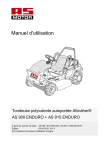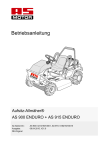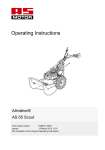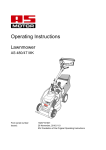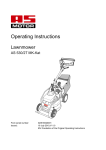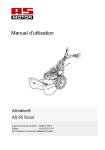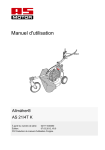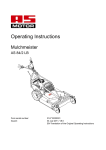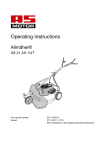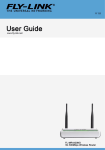Download Operating Instructions
Transcript
Operating Instructions Ride-on Allmäher® AS 915 ENDURO From serial number: Issued: 01821110001 21 December 2011,V16.0 EN-Translation of the Original Operating Instructions Preface Intended use Please fill in all data referring to your device. When ordering spare parts, provide your dealer with the device and engine number. The device is intended for cutting and mulching grass or similar vegetation in agriculture, forestry, and landscape conservation. Serial number: Only use attachments and cutting tools authorised by “AS-Motor Germany”. Engine number: Date of purchase: Address of dealer: Any use exceeding this purpose is inadmissible. The manufacturer is not responsible for any damage resulting from this. Observe the required maintenance and repair measures. The user of the device is responsible for accidents or damage to other persons or their property! Dear customer: The device must not be used: Congratulations on your purchase. You have acquired a reliable quality product by “ASMotor Germany”. This product has been manufactured according to modern manufacturing methods and comprehensive quality assurance measures. Only when you are satisfied with your device, we have attained our goal. Read these operating instructions carefully and attentively so that your device operates smoothly and you and others are safe from any hazards. If you have questions concerning your device, please contact your dealer or call our customer service (telephone +49/(0)7973/9123-0). For international AS partners, please see: www.as-motor.de/worldwide. “AS-Motor Germany” wishes you much joy with your new device. 2 To cut hard objects, rocks, rubble, or pieces of wood. To trim bushes, hedges, and shrubbery. To cut vegetation on building roofs. To clean (vacuum) footpaths. As shredder for shredding tree and hedge cuttings. As drive unit for work tools and any type of tool sets that are not authorised by “AS-Motor Germany”. The device is not licensed for driving on public roads. Contents Preface ......................................................... 2 Intended use ................................................ 2 Explanation of the symbols........................ 4 Symbols in the instructions ........................ 4 Symbols on the device .............................. 4 Safety instructions ...................................... 6 Get informed! ............................................. 6 User restrictions and hours of operation ... 6 Safe handling of fuel .................................. 6 Check the device prior to use .................... 7 Use caution during operation .................... 7 Prior to mowing.......................................... 7 Use caution when mowing ........................ 7 Caution when using accessories ............... 9 When work is completed ........................... 9 Use caution during maintenance and repair ......................................................... 9 Device description .................................... 10 Control elements ....................................... 11 Front area ................................................ 11 Brake ....................................................... 11 Control lever at the seat .......................... 12 Drive/idle mode........................................ 13 Fuel valve ................................................ 13 Transport.................................................... 13 Transport on pallets ................................. 13 Transport of ready-to-use device ............ 13 Assembly ................................................... 14 Scope of delivery ..................................... 14 Unpacking................................................ 14 Mounting .................................................. 14 Information on mowing............................. 15 Prior to starting ......................................... 16 Checking the oil level .............................. 16 Fuel.......................................................... 16 Tanking up ............................................... 16 Adjusting the seating position .................. 16 Starting....................................................... 16 Safety switches ....................................... 16 Starting the engine .................................. 16 Engaging the blade ................................. 17 Oil pressure switch .................................. 17 Driving ........................................................ 17 Braking .................................................... 17 Driving ..................................................... 18 Differential lock ........................................ 18 Switching off and parking ........................ 18 Maintenance and cleaning ....................... 18 Preparations ............................................ 21 Cleaning the device ................................. 21 General inspection .................................. 21 Checking the parking brake..................... 21 Checking the foot brake .......................... 21 Grease lubrication ................................... 22 Checking the blade.................................. 22 Maintaining the engine ............................ 23 Checking the engine oil level .................. 23 Checking the spark plugs ........................ 23 Cleaning the air filter ............................... 24 Checking and charging the battery ......... 24 Hydrostat transmission ............................ 24 Storage ....................................................... 25 Storing the device.................................... 25 Longer storage ........................................ 25 Restarting ................................................ 25 Spare parts ................................................ 25 Wear parts.................................................. 25 Accessories ............................................... 26 Disposal ..................................................... 26 Warranty..................................................... 26 Troubleshooting ........................................ 27 Technical data ........................................... 31 Declaration of conformity......................... 33 3 Risk of injury caused by rotating components! Explanation of the symbols Symbols in the instructions In these operating instructions, the following symbols are used to denote special dangers. Danger of bursting while tires are inflated. Observe the admissible tire pressure (see Technical data). Warning. These symbols denote special dangers. The device generates poisonous exhaust fumes as soon as the engine is running. Some of these gases are odourless and invisible. Never let the engine run in closed rooms. Prohibition sign. These symbols denote inadmissible procedures. Directive sign. These symbols denote required protective measures. Risk of tipping! Symbols on the device The following symbols are placed on the device to inform you must be careful and attentive when using the device: Working with the device requires extreme caution. The quickly rotating blade of the device can cause lifethreatening injuries or major property damage. Read the operating instructions before you use the device. Make sure that no one is within the danger zone of the device. The danger zone extends for at least 50 metres. Hot surfaces or components. Do not touch the engine or the silencer. Risk of injury due to running belt drive! When the engine is running, never reach into the belt drive. 4 MAX. 17° L WA When positioned sideways to the slope, the device is stable up to 17°(in accordance with the standard measuring method). Sound level on the device. 98 dB Noise is causing health problems. Use personal ear protection to avoid hearing damage. ASE GRE 1 Warning! Risk of injury caused by rotating blades or parts. Objects can be ejected. Make sure that no one is within the danger zone of the blade (at least 50 metres). 5 2 3 4 Lubrication chart Position of grease nipples for grease lubrication. Observe the maintenance instructions. Type plate The type plate on the device provides you with information on the device type and the technical data. Warning! Explosion hazard! Keep the fuel away from ignition sources and do not smoke while handling the device. Observe the safety instructions regarding the fuel! 1 2 3 4 5 6 7 AS-MOTOR GERMANY GmbH & Co KG Ellwanger Stra ße 15 D-74424 B ühlertann Rasenm äher AS 53 B6 RB-Kat 4,4 kW (6,0 PS) / 2800 (1/min) 68 kg 2011 SNR: 020909090055 1003s 8 1 2 3 4 5 6 7 8 9 9 Name and address of the manufacturer Device designation Type designation Rated power output in kW / engine speed Weight Year of manufacture Serial number CE marking Sound level LWA 5 Safety instructions Safe handling of fuel Danger! Fuel is toxic and highly inflammable. Danger of fire and explosion! Keep the fuel away from ignition sources and do not smoke while handling the device. Do not inhale fuel vapours; they are dangerous to your health. Get informed! For your safety, read these operating instructions with care. Familiarize yourself with the control elements and the proper use of the device. Share these operating instructions with other users of the device. Before you use the device for the first time, let the dealer instruct you regarding safe use. Use gloves and avoid skin contact with the fuel. Practise operating the mower first in a wide, open, and flat terrain without the blade drive. User restrictions and hours of operation Never give your children or other persons who are not familiar with the operation instructions permission to use the device. Persons under 18 years old may operate the device only under supervision. Local regulations will determine the minimum age of the user and the hours of operation. Unsuitable for the operation of the device are persons Who are under the influence of alcohol, drugs, or medicine that slows down reaction time. With physical and mental impairments. People fitted with pace makers are not allowed to touch any current carrying parts of the ignition system. Fuel up outdoors only when the engine is cool and not running. Use a filler or funnel. Do not spill any fuel and do not let the fuel get into the canalisation or ground water. If you spilled fuel, do not start the device until the fuel vapours have evaporated (wipe dry). Move the device away from the area where the fuel was spilled. Always close the tank cap securely and do not open it while the engine is running or the device is still hot. Drain the fuel tank only when outdoors. Use a suitable container or run the tank empty. Keep the fuel away from children and store it in a suitable container in a dark, cool, and dry location. Never park the device with fuel in the tank inside a building where fuel vapours could come in contact with open fire or sparks. Immediately replace a damaged fuel tank or tank cap (authorised dealership). First aid When swallowing fuel or inhaling fuel vapours, do not force vomiting and immediately consult a doctor. In case of skin contact, immediately wash with water and soap. Change your soiled clothing as soon as you can. 6 Measures in case of a fire In case of a fire, use foam, dry powder extinguisher, or carbon dioxide (CO2). Never douse with water! Check the device prior to use Prior to each use, carry out a visual inspection of the blade, protection flap, drive and fastening parts for proper condition and firm seating. Never use the device when covers, impact protection or protection flaps are defective or not installed. Do not remove, change or override any safety devices or control elements. Observe the maintenance instructions and replace damaged or worn parts immediately. Check the blade brake for proper function by switching off the blade clutch. The blade must come to a standstill from full speed within less than 5 seconds. Check the parking brake for proper function (see Maintenance). Use caution during operation Do not start the engine: if fuel was spilled. in closed or poorly ventilated rooms (danger of poisoning!). if there are other persons nearby. After every stop and before you shut down the engine, actuate the parking brake. This prevents the device from accidentally rolling away. Do not touch the exhaust, the engine, and the gearbox. They become very hot during operation and you can get burned. Resulting unintentional movements constitute an additional injury hazard. Switch off the blade and wait until the blade comes to a standstill, when you drive on surfaces other than grass. Switch off the engine and wait until the blade comes to a standstill and remove the ignition key before you transport the device. if you step away from the device, even for just a short time. before you clean or check the device or before you carry out work on the device. before you unblock or unclog the discharge area. Prior to mowing Personal protective measures While mowing, always wear sturdy footwear with good grip, long trousers, and gloves. Do not mow in open sandals or bare feet. Noise is causing health problems. Use personal ear protection to avoid hearing damage. Wear safety glasses and headgear. Preparing the mowing area Prior to mowing, carefully check the perimeter of the lawn. Remove rocks, pieces of wood, bones, wires, and other objects that could be picked up and thrown out by the device. Use caution when mowing Risk of injury Always stay within hearing range to other persons who can assist you in case of an emergency. 7 Danger! Risk of injury caused by thrown out objects. Never mow while persons, children, pets, or property are in the vicinity. The danger zone extends for at least 50 metres. max. 17° The area in front of and to the right of the device is especially dangerous. Keep your hands and feet away from rotating parts. Mow only in daylight or good artificial light. Do not transport any person on the device. Be extremely cautious when moving in reverse. Pay attention to traffic when working close to roads. When using the device over a longer period of time, vibrations can cause disturbances in the blood supply of the hands. A generally accepted usage time cannot be determined. Use gloves. Take breaks on time. Have an authorised service centre check the device immediately if the blade hit an object. if the device starts to vibrate unusually severely. Caution when mowing slopes Danger! If the engine shuts down while you are mowing, the device can roll away. Immediately actuate the parking brake to prevent the device from rolling away. Do not mow excessively steep slopes. For safety reasons, use the device only on less than 17°slopes. Use a clinometer if you are not familiar with the slope (see accessories). Always mow up- and downwards, never in horizontal directions. Always move upwards first. If you are unsuccessful at moving upwards first, you must not mow the slope. Never move downwards if you were not successful at moving upwards. Be extremely careful when changing the direction. Do not turn on a slope. Only mow when you are familiar with the terrain and the terrain is clear of obstacles. Pay attention to bumps, holes, and other visible hazards. Do not mow close to danger zones (e.g. walls, steep declines, etc.). Prior to entering the slope, always actuate the differential lock. Move on slopes only when the differential lock is actuated. Always keep the speed low when moving on slopes. Do not start abruptly and do not brake abruptly. Hold the steering wheel tightly so that the device does not swerve. Only park the device on flat surfaces. Drive has good braking efficiency which can only provide sufficient grip on a non-slip surface! If the mower starts to slide, you can regain control by actuating the brake. Uncontrolled handling is due to: 8 When mowing slopes, there is a risk of slipping and tilting! poor tire grip. speeding. abrupt braking. an inappropriate task for the device. poor knowledge of the area. slope angles that are too steep. Risk of tilting If the wheels facing uphill encounter obstacles such as roots, branches, rocks, bumps, etc., the mower can tilt or slide. Risk of slipping When the ground is wet or loose, use extreme caution to prevent the mower from slipping. Use extreme caution when moving downhill. On cut plant material, no matter if wet or dry, the risk of slipping is high. Mowing surfaces with fire hazard Carry a sufficient amount of suitable extinguishing agent. If side inclination is too great, fuel may leak from the carburetor or the tank. This poses a fire hazard! Observe the mowed surface also after moving is completed to ensure that no fire will start. To avoid risk of fire, keep the following components free of dirt, grass, hay, leaking oil, grease, etc: Engine Silencer (manifold, guard, clearances) Battery Area around the fuel tank Caution when using accessories Be careful when pulling loads: Only use tow-bars authorized by “AS-Motor Germany”. Observe the maximum load carrying capacity (Technical data). Observe the safety instructions in the operating instructions of the tow-bar. Only transport loads that you can handle safely. Only drive on slopes up to 10°. Do not take tight corners. Be extremely cautious when moving in reverse. When work is completed After each mowing, close both fuel valves. Prior to leaving the device, wait until the blade comes to a standstill and remove the ignition key. After switching it off, let the device cool down for at least 20 minutes before you store it in a dry, closed, sufficiently ventilated room. Never store the device when there is fuel in the tank inside a building where fuel vapours might come into contact with open fire or sparks. Use caution during maintenance and repair Only carry out maintenance work as described in these operating instructions. Have an authorised service centre carry out all other work. Prior to starting any maintenance work, wait until the engine comes to a standstill and pull off the spark plug connectors. We explicitly point out that, in accordance with the Product Liability Act, we are not liable for damages that were caused by our devices if worn or damaged parts were not repaired or replaced on time these damages were caused by improper repair. when changing a part, our original parts or parts authorised by use were not used. the repair work was not carried out by an authorised service station. The same applies for spare parts and accessories. 9 Device description 3 12 7 10 2 6 5 9 1 8 4 11 1 Front impact protection 2 Tank cap 3 Side supports 4 Fuel valve 1 5 Fuel valve 2 6 Engine oil filler neck 7 Ventilation grid 8 Fuses circuit protection 9 Side plates impact protection 10 Engine 11 Type plate 12 Support tube 10 Ignition lock (5) Control elements The ignition lock has three positions. Front area 1 1: Ignition off. The key can be removed. 2 3 3 4 2 3: Electro starter on. 5 1 2: Ignition on. Control lamp (4) illuminates. Brake 1b Differential lock (1) With the left foot pedal, actuate the differential lock. Pedal is pushed: Differential lock on Pedal is not pushed: Differential lock off Operating hours counter (2) The operating hours counter is running as soon as the ignition is switched on. The counter displays hours and 1/100 hours. Blade clutch switch (3) The blade clutch switch is a protective device. If you declutch the blade the blade comes to a standstill within 5 seconds. Clutching blade: Press the lock at the bottom part of the rocker switch upwards and press the rocker switch upward (ON). 1a 2 Foot brake Braking: Release the drive lever and press the right foot pedal (2) down. Parking brake Releasing the parking brake: Press the right foot pedal down, press the locking lever (1a) down. Putting on the parking brake Press down the right foot pedal and pull the locking lever all the way up (1b). Then the foot pedal remains in down position. Declutching blade: Press the switch down (OFF). 11 Control lever at the seat 1 2 Accelerator (4) Via the accelerator, you change the engine speed. 3 4 5 Highest speed (full throttle): Press the accelerator all the way down. Lowest speed (idling speed): Pull the accelerator all the way up. Drive lever (5) Cutting height adjustment (1) 1 2 The cutting height of the lawn can be set to four positions. The drive lever is required for driving forward and in reverse as well as to stop the mower. The further you move the lever in one or the other direction, the faster the device moves. Moving forward 3 4 Position "Stop" is the transport position. Stopping (neutral position) Moving in reverse Sitting position Press the lever (2) to the left and move the seat to the desired position. Lever for choke (3) The choke is only closed when the cold engine is started. As soon as the engine is running, open the choke. Closing the choke: Pull out the lever for the choke (3) by pulling if forward Opening choke: Push back the lever for the choke (3). 12 Drive/idle mode Transport To push the mower without engine drive, unlock the drive below the driver seat and release the parking brake. Subsequently, the mower can only be braked via the foot brake. 1 Transport the device on a freight vehicle or a trailer which is designed for a carrying capacity of at least as great as the empty weight of the device. Transport on pallets For transport over short distances, use a fork lift or a lift truck. 2 For longer distances, load the device with a fork lift onto a freight vehicle or trailer. The user must be authorised to operate a fork lift. When the machine is lifted, all persons must step away from the working area of the fork lift. 1: Locked 2: Unlocked (idling) Fuel valve At the bottom of the tank, at the left rear and at the right front, there is one fuel valve each. 1: Reserve (R) 2: Open Notice! Drive the fork lift completely under the longitudinal beams of the wooden pallets. 3: Closed (C) 1 2 Transport of ready-to-use device 3 Turning to the left: Open Turning to the right: Closed Warning! Risk of injury due to the heavy weight of the device. The device can fall over and fall down and cause severe injuries. Observe the following notices. Prior to transport, let the device cool down for at least 20 minutes. Close the fuel valves. 13 Loading Screws, nuts and discs for assembly of the steering wheel, support tube, and the side supports. Operating instructions of the engine manufacturer. Use suitable ramps for loading that can carry the empty weight of the device + 100 kg. are wider than the device. have a slip-free surface. 1. Put the device in front of the ramps and make sure that the ramps - are as wide as the wheel gauge of the device. - are tightly secured to the platform. Unpacking 1. Remove the carton, the frame and the film. 2. Check the air pressure of all tires (see Technical data). Mounting - are not steeper than 15°. 2. Carefully drive the device via the ramps onto the platform. 1 3. Secure the device with belts to the frame elements that can hold the weight. 4. Secure the device against rolling, sliding, tilting, and fuel and oil leakage. Unloading the device 1. Undo the transport fastenings. 2. Drive the device carefully down the ramps of the platform. Assembly 1. Mount the steering wheel (observe the fitted key (1)). Scope of delivery The device is delivered in a carton on a pallet. The scope of delivery includes: 14 The device. These operating instructions. Warranty card. Steering wheel with fitted key. 2 side supports. 2 protective covers for side supports. Support tube. Protective cover for support tube. Ignition key. 2. Push the protective covers over the side supports and close the velcro closures of the protective covers. 3. Bolt both side supports to the device. Information on mowing Prior to mowing, check your device for completeness, proper functioning, and cleanliness. A dirty ventilation grid can damage the engine and a dirty protective grid at the silencer poses a fire hazard. Frequent engagement and disengagement of the clutch increases wear of the blade drive belt and the blade brake. Especially in case of high grass, clutch engagement leads to overload. To keep the area well maintained, mow frequently and keep the grass short. 4. Push the protective cover over the support tube and close the velcro closures of the protective cover. 5. Screw the support tube to the device. 6. Remove both metal transport securing devices (one metal hook in the front and one metal hook in the rear is bolted to the pallet). 7. Release the parking brake, unlock the drive and push the mower off the pallet. 8. Relock the drive. Connecting the battery Caution! When the battery is connected, there is a risk of short circuit. Do not put tools or metal objects on the battery. Observe the assembly order for connecting and disconnecting the battery. Only mow with a sharp and undamaged blade. Have the blade sharpened and balanced regularly (by authorised service centre). Do not mow when the grass is wet or when it is raining. The turf may be damaged and there is a danger of slipping! Turn the device around only in already mown sections. Set the cutting height so that the blade does not touch the ground even in case of terrain unevenness. Always set the blade to transport position when you do not mow. For mowing, always turn the accelerator lever to full throttle to achieve the best mowing performance. 9. Connect the red cable (+) to the battery. 10. Connect the black cable (-) to the battery. To avoid blockage during the ejection of grass, we recommend, for flat terrain, to proceed according to the mowing patterns. Mulch is shredded into much smaller pieces when you mow the terrain once again in the opposite direction. 15 Prior to starting Starting Danger! During startup, there is a risk of injury caused by the rotating blade. Make sure that no one is within the danger zone of the blade. Checking the oil level Caution! Before mowing, always check the engine oil level and the oil level in the hydrostat (see Maintenance). Fuel Safety switches As fuel, use unleaded petrol (see operating instructions of the engine manufacturer). The device is equipped with safety switches. To start the engine, the following requirements must be met: Tanking up Danger! Fuel is ignited by hot engine parts. Prior to filling up, switch off the engine and wait for at least 20 minutes until the engine has cooled down. Observe the safety instructions regarding the fuel! A driver sits in the driver seat. The blade clutch is switched off. The drive lever is in neutral position. If the engine is running and the driver leaves the seat, the engine is shut off. Filling in the fuel: If the engine was shut down due to a safety switch, turn the ignition key to position “Ignition off”. By this, you will avoid discharging the battery. 1. For filling, use a canister with a filler spout or use as funnel. Starting the engine 2. Open the canister carefully so that the existing overpressure is discharged slowly and no fuel spurts out. 3. Open the tank cap carefully so that the existing overpressure is discharged slowly and no fuel spurts out. Start the device only when it is positioned on even and firm terrain 1. Open both fuel valves. 2. Sit down on the driver seat. 3. Switch off the blade clutch. 4. Fill the fuel tank. 4. Move the drive lever to neutral position. 5. Screw the tank cap on tightly. 5. Only for cold start: Move out the lever for the choke. Adjusting the seating position Adjust the seat in the longitudinal direction until your feet are positioned on the inclined support plates and you sit comfortably. 6. Move the accelerator lever to middle position. 7. Turn the ignition key to start position. 8. After the engine starts, release the ignition key and press the lever for the choke back in. 9. For mowing, set the accelerator lever to max. speed. 16 If the engine does not start after 5 seconds, release the key and wait for approx. 15 seconds before trying to start the device again. Oil pressure switch Danger! If the engine cuts out while the device is used, the device can roll away. Immediately actuate the parking brake so that the device does not roll away. Engaging the blade Only engage the blade when it turns freely and does not come into contact with objects or the floor. Do not engage the blade in uncut grass because the blade drive otherwise becomes overloaded, can be damaged, or can wear prematurely. 1. Start the engine. 2. Move the lever for the cutting height adjustment to the highest cutting position. 3. Release the Foot brake. The oil pressure switch of the engine shuts off the engine if damage of the engine caused by inadequate oil pressure is likely to occur. This can be the case when: The oil level is too low. The device is in an extremely inclined position in excessively steep terrain. To restart the engine, the device must be positioned on an even surface. Always check the oil level. 4. Switch on the blade clutch switch - the blade starts up. 5. Set the desired cutting height. If you set the cutting height to transport position during mowing, the blade is automatically disengaged. Reengaging: 1. Switch off blade clutch switch. 2. Move the lever for the cutting height adjustment to the highest cutting position. Driving Danger! Mowing on a slope is dangerous. There is a risk of tilting and slipping. Observe the safety instruction for mowing on slopes. In case of a hazardous situation, switch off the drive and declutch the blade. 3. Release the Foot brake. 4. Switch on the blade clutch switch - the blade starts up. 5. Set the desired cutting height. Disengaging the blade when running over paths: 1. Switch off blade clutch switch. Braking Warning! The brake does not work if you continue to hold the drive lever while braking. Release the drive lever when you actuate the foot brake. To stop, move the drive lever slowly to neutral position or step on the foot brake. The foot brake acts on the rear wheels. When the foot brake is actuated, the drive moves to direction "STOP" (neutral position). When the 17 foot brake is pressed quickly and fully, the drive lever swivels all the way to neutral position. Use the actuation via foot pedal only in exceptional circumstances because the mower stops abruptly. Driving 1. Start the engine. 2. Release the parking brake. 3. Slowly move the drive lever to the desired driving direction. The further the lever is moved away from the neutral position, the faster the mower moves. 4. To stop, move the drive lever slowly to neutral position or step on the foot brake. When you actuate the foot brake and switch on the drive, you can hear an alarm tone. Switching off and parking 1. Move the drive lever slowly to neutral position. 2. Turn the accelerator lever to idle speed. 3. Switch off the blade clutch. 4. Move the lever for the cutting height adjustment to transport position. 5. Actuate the parking brake. 6. Turn the ignition key to “ignition off”. 7. Wait until the blade comes to a standstill before you step away from the device. Warning! Risk of injury in case of unauthorised use. Always remove the ignition key when you do not use the device. Differential lock 8. Remove the ignition key. The differential lock connects the two rear wheels rigidly to each other. This improves traction. Actuate the differential lock when a wheel slips. 9. Close both fuel valves. Always actuate the differential lock when moving downhill. This improves the driving stability of the device. The risk of sliding or swerving of the rear is reduced and safe braking is possible. Maintenance and cleaning Regular maintenance keeps your device ready for use. Driving in curves while the differential lock is actuated is only possible with limitations. If you do not observe the maintenance notices, faults may occur that are not covered by the warranty. Operational safety is endangered as well. To avoid excessive wear: Contact your authorised service centre for checkup if you detect problems during maintenance. 18 actuate the differential lock only when the device is stopped, if possible. always step on the pedal all the way. release the differential lock when it is no longer absolutely needed. Component Device Action Maintenance interval Before and after each use Annually or every 50 h Check for safe working condition. ■ ▲ Clean. ■ Customer service. Fuel ▲ Check fuel level. ■ Is the tank cap closed? ■ Tank, fuel valves, and fuel line Check parts for leaks and proper condition. ■ ▲ Ventilation grid Clean. ■ ▲ Engine cooling Clean. Spark plugs Check/adjust. ▲ ■ Replace. Air filter Check/clean. ■▲ ■ Replace. ▲ ■▲ Blade and fastening components Check for wear and damage. See chapter Checking the blade. Blade brake Does the brake function properly and does the blade stop within 5 seconds? □ ▲ Drive lever Does the device stop when the lever is in neutral position (STOP)? □ ▲ Does the lever move to neutral position when the foot brake was actuated? □ ▲ ■ Change. ▲ ▲ V-belt Are the V-belts tensioned correctly, without fissures, and in good condition? Bowden cables Check for proper function and ease of movement. ■ ▲ Acceleration lever Check for proper function. □ ▲ Chassis and impact protection Check for rust and fissures and check the welding seams. ■ ▲ Are all protective device fastened correctly and properly functioning? ■ ▲ ▲ 19 Component Action Maintenance interval Before and after each use Annually or every 50 h Label Condition of the labels. ■ ▲ Engine See operating instructions of the engine manufacturer. ■ ▲ Check oil level (see operating instructions of the engine). ■ ▲ Oil change. ▲ Oil filter change. ▲ Parking brake Check the parking brake. ■ ▲ Foot brake Check the foot brake. □ ▲ Flammable material Remove easily flammable debris buildup from the engine and the device. ■ ▲ Steering Check the clearance. ■ ▲ Tires Check tires and tire pressure if necessary. ■ ▲ Safety switches Check the switches at the driver seat, cutting height adjustment, and drive for proper function. ■ ▲ Ignition lock Check for proper function. □ ▲ Hydrostat transmission Check oil level. ■ ▲ Differential gear Eliminate leak points, if necessary. ▲ Oil change after 50 h and every 200 h thereafter. ▲ Perform oil change. ▲ Check for oil contamination. Battery Check the charging condition. Lubrication See chapter Grease lubrication. ■ □ ▲ 20 By the user when the engine is not running. By the user when the engine is running. By the authorised service centre. ■ ▲ ▲ ■ ▲■ Preparations Prior to all maintenance and cleaning work: 1. Let the device cool down for at least 20 minutes. 2. Close the fuel valve and the tank ventilation. 3. Disconnect the minus pole of the battery. General inspection To ensure proper working order of the device, regularly check all nuts, bolts, screws, fuel line connections, air filters, etc. for firm seating. Check the ignition cable and the spark plug connectors for damages. Immediately replace any damaged or worn parts, especially in regards to covers, silencers, or fuel tank (authorised service centre). Check the safety switches for proper function. The engine must not be started when: There is no driver in the driver seat. The blade clutch is switched on. The drive lever is not in neutral position. If the engine is running and the driver leaves the seat, the engine must shut down. Caution! During repair and maintenance work, lift the device only by the frame. You can use the points marked with arrows, located at the front of the towing eye and at the frame below the seat, as mount points. Cleaning the device After each use, you should clean the device thoroughly, especially the bottom side and the blade. Contact an authorised service centre if one of these conditions is not met. Checking the parking brake Danger! If the parking brake is incorrectly adjusted, the device can roll away. Make sure that the parking brake is always functioning properly. 1. Put the device on a non-slip surface (e.g. concrete or asphalt). Stuck grass or dirt affect the grass discharge and the cutting quality. For a sufficient engine cooling, keep the engine cover, ventilation grid, and the engine clean. 2. Unlock the drive. Fire hazard! Pay special attention so that components at the silencer are clean. If the rear wheels lock, the parking brake is correctly adjusted. If you can move the device, the parking brake must be readjusted by an authorised service centre. For cleaning use a hand brush. Remove stubborn soiling with a wooden or plastic spatula. Clean the outer housing parts with a cloth. Do not rinse off the device with a water jet or high pressure cleaner! Do not use aggressive cleaning agents. 3. Actuate the parking brake. 4. Try to move the device. Checking the foot brake Check if the drive lever return to STOP when the brake pedal is actuated. 21 Grease lubrication Twisted cutting blades ASE GRE 1 2 3 1 5 3 2 5 2 3 4 On the lubrication chart, the position of the grease nipples are marked. 1. Clean the grease nipples. 2. Lubricate the grease nipples with a hand grease gun (1-2 strokes). 3. Remove any excess grease that has squeezed out from the bearing points. Checking the blade Danger! Improperly mounted and maintained blades pose a severe injury hazard. Work at the blade shall only be performed by an authorised service centre. If the cutting blades (2) strike a foreign object, they can be twisted (overload protection). Never mow when the cutting blades are twisted. Turn the cutting blades (2) back to their initial position. If the cutting blades cannot be turned back, have the cutting mechanism checked for damages and the cutting blades turned back or replaced by an authorised service centre. To prevent unbalance replace or reverse the cutting blades in pairs only! Work on the blade requires special qualifications because an unbalance test is required and the torques must be observed. Before and after each mowing operation and in case of significant changes, check for wear, damages, and cracks. Vibrations indicate that the blade or the mulching blade is worn excessively or on one side only. Improperly sharpened blades or mulching blades increase the device load and result in fatigue cracks and breakage! Ejected pieces can cause severe injuries. 22 It is absolutely necessary to change the cutting blades and the fastening parts when the width of a cutting blade (4) is below 50 mm. when the thickness of the cutting blade at any point is below 1 mm (exception: cutting edge). when the cutting blades are damaged or deformed. It is absolutely necessary to change the cutter bar (1), the mulching blade (5), the cutting blades (2) and the fastening parts if damages are found. At the least once per year or every 50 operating hours, whether there is wear or not. The material deteriorates, may show cracks and this can endanger persons and material goods. Checking the condition of the cutting blade screws Danger! When a screw head is worn, the cutting blades can become loose. Check all screws used for fastening the cutting blades! Maintaining the engine Danger! If the speed of rotation is set too high, objects can be ejected. The engine can be damaged and noise pollution increases. Do not change the basic setting of the carburetor or the speed control. The operating instructions of the engine are prepared by the engine manufacturer. They contain the maintenance instructions and the warranty conditions for the engine. If warranty work for the engine is required, please contact your authorised service centre or the nearest authorised engine dealer. Checking the engine oil level The screw head (3) experiences wear during mowing and must be replaced at the latest when the thickness is 2 mm. The oil level must remain between the two markings of the oil dipstick. Make sure that the oil level is never below the bottom marking; otherwise the engine can be damaged. Never fill in oil above the top marking. Otherwise, there is a risk that the oil enters and destroys the air filter. To avoid unbalance, the cutting blades must be replaced in pairs only. For this, observe the attached operating instructions of the engine. You can easily recognize an original ASblade by these stamps: Checking the spark plugs AS EXXXXX EXXXXX indicates the spare parts number. Checking the blade clutch Check the blade clutch for proper function by declutching the blade. The blade must come to a standstill from full speed within less than 5 seconds. Contact an authorised service centre if this is not the case. Danger! The ignition system generates an electromagnetic field. Wearers of pacemakers must not work on live parts. Soiled spark plugs reduce the engine output. Clean the electrode of the spark plug with a brass wire brush. Check the electrode gap (see operating instructions of the engine manufacturer). Make sure that the insulator around the electrode is not damaged. Never use a damaged spark plug. 23 Tighten the spark plug using the correct torque (see operating instructions of the engine manufacturer). Always check both spark plugs. Cleaning the air filter Danger! Cleaning agents pose a fire and explosion hazard. Never clean the air filter with flammable solvents. Always make sure that the air filter is clean. A dirty air filter affects the engine output and increases the fuel consumption. Independent from the number of operating hours the filter inserts should be changed at least annually. Do not operate the engine without air filter. For this, observe the attached operating instructions of the engine. Checking and charging the battery Danger! When the battery is being charged, explosive gases escape. Never charge the battery close to flames. Avoid sparking and do not smoke. Caution! When the battery is connected, there is a risk of short circuit. Do not put tools or metal objects onto the battery. Observe the assembly order when connecting and disconnecting the battery. required charging current and terminate the charging process when the battery is full. Charge the battery before you put the device away for winter storage. A fully charged battery lasts for approx. 4 months before it needs to be recharged. Caution! Never confuse the plus and minus terminals. 1. Pull the tank out off the holders and put it to the right. 2. Disconnect the black cable (-). 3. Disconnect the red cable (+). 4. Dismantle the battery from the device. 5. Charge the battery. 6. Mount the battery into the device. 7. Connect the red cable (+). 8. Connect the black cable (-). 9. Remount the tank. Hydrostat transmission 1 If the starter does not turn the engine or turns it too weakly charge the battery. After a standstill of several hours on an even surface, the oil level must have reached the marking (1) of the oil container. If this is not the case, top up the oil (see Technical data). The battery is maintenance-free and gastight. Only fill in oil until the oil level has reached the marking of the oil container. Use electronically controlled charging systems. These charging systems detect the connected battery and charge it with the 24 Storage Restarting Storing the device If you want to start the device after a longer storage, carry out the tasks described in chapter Maintenance. Keep the device in a closed, dry, and well ventilated room and out of reach of children. Always eliminate all problems of the device before you store it so that the device is always in a safe-to-operate state. Let the engine cool down before you store the device in closed rooms. Longer storage 1. Observe the safety instructions regarding the handling of fuel. 2. Draining fuel tank: Put a piece of a tube on the fuel valve and fill the fuel in an adequate fuel container. 3. Emptying carburetor: Start the engine and let it run until it stops on its own. 4. Clean the device thoroughly. 5. Touch up defects in painting (for spray paint, see Accessories). 6. Preserve the engine: - Unscrew the two spark plugs. - Fill a tablespoon of engine oil into each spark plug opening. - Briefly actuate the starter (oil is distributed in the cylinder). - Screw the spark plugs back in. Spare parts The reliable and safe operation of the device also depends on the quality of the spare parts used. Only use original spare parts and accessories that were approved by “AS-Motor Germany”. When foreign parts are installed, the warranty and guarantee shall be void for the foreign part and for the device and for any resulting damage. Inform your authorised service centre about the device type and serial number of your devices when you order spare parts. Wear parts Some parts are wear parts. They wear during use and must be replaced. The warranty does not cover the following parts: Blades, cutting blades, cutter bars, blade bolts, sliding plates, V-belt, chains, Bowden cables, starter ropes, pressure plates, air filters, spark plugs, disc springs, lock washers, fuses, discs, thrust plates, pressure discs, protection skirts, impact protection, wheels, tires. - Do not put the spark plug connector on! 7. Remove the ignition key and keep it separate from the device. In autumn, have your device checked by an authorised service centre! Also observe the notices on storage in the attached operating instructions by the engine manufacturer. 25 Accessories Available accessories: Trailer: E09311 Trailer hitch: E09313 Snow blade: E09315 Snow chains: E09316 (set) Front lawn tires: E09318 (set) Rear lawn tires: E09319 (set) Spray paint 400 ml, colour orange: E04606 Adjustable seat unit: E09348 Clinometer E11835 Disposal The device cuts and shreds the plant material in a single operation. Shredded plant material decomposes quickly, can be utilized as fertilizer, and, therefore, be left on the ground. Dispose of waste oil and fuel in accordance with the local regulations or return it to an oil shop. Packaging, device, and accessories are made of recycable materials and must be disposed off accordingly. Warranty The conditions of the warranty can be found on the reverse side of your warranty card. Send the filled-out warranty card immediately after the purchase of your device to “AS-Motor Germany” or the supplier. Otherwise, the warranty is no longer valid. Preserve the proof of purchase or the warranty card that was filled out by the vendor. 26 You can find an authorised service centre on our home page www.as-motor.de. Troubleshooting The following table contains the most frequent problems and their elimination. If more problems occur, contact the closest authorised service centre. Problem Possible cause Remedy Starter does not turn Safety switches are not actuated. Battery is empty: Engine does not start Ignition key was not in position "Off". Standstill period was too long. Drive lever to neutral position. Switch off blade clutch switch. Lever for cutting height adjustment to transport position. Put driver in seat to activate seat contact switches. Charge the battery (see Checking the battery) or have authorised service centre do so. Fuse is defective. Replace (if necessary, have authorised service centre do so). Battery is defective. Replace the battery (authorised service centre). Fuel valves are closed. Open the fuel valves. No fuel in the tank. Refill fuel. Choke is open. Close the choke. Device was tilted – oil leaked into the air filter. Replace the air filter, unscrew the spark plugs, and start several times while fuel valve is closed, dry spark plugs and screw them back in. Engine was flooded due to too many start attempts. Unscrew spark plugs and start several times when the fuel valve is closed, dry the spark plugs and screw them back in. Spark plug connector is pulled off. Observe safety instructions! Put spark plug connector back on. Air filter is soiled. Clean air filter (see also Maintenance and cleaning). 27 Problem Possible cause Remedy Spark plugs are sooted, damaged or incorrect electrode gap. Clean spark plugs and check electrode gap (see also Maintenance and cleaning) If necessary, replace the spark plugs. Housing of the mower is jammed. See also Maintenance and cleaning. No oil pressure: Too little engine oil. Check engine oil level, refill. No oil pressure: Slope is too steep. Move the device to a flat position. Fuel is of poor quality, dirty, or old. Clean the fuel system (authorised service centre). Always use fresh fuel. Choke is closed. Open the choke. Air filter is soiled. Clean air filter (see also Maintenance and cleaning). Fuel is of poor quality, dirty, or old. Always use fresh fuel. Spark plugs are sooted, damaged or incorrect electrode gap. Clean spark plugs and check electrode gap (see also Maintenance and cleaning). If necessary, replace spark plugs. Device does not move Drive is unlocked. Lock the drive. Hydrostat drive is overheated. Cool it down (see also Maintenance and cleaning). The blade does not rotate Lever for cutting height adjustment in transport position. Lower the lever for cutting height adjustment to any cutting height. Electromagnetic clutch has low voltage. Let engine run at medium speed for a while or charge battery. V-belt is insufficiently tensioned or damaged. Authorised service centre. Unbalance at the blade caused by incorrect sharpening or chips on the blade. Have blade balanced and resharpened by an authorised service centre. Replace a damaged blade immediately. Blade drive shaft is bent by collisions with foreign objects. Authorised service centre. Engine starts badly or runs irregularly Strong vibrations during operation 28 Problem Possible cause Remedy Engine fastening is loose. Authorised service centre. Blade fastening is loose. Authorised service centre. Loose fastening elements. Authorised service centre. Silencer defective. Authorised service centre. Air filter is soiled or drenched with oil. Clean or replace the air filter (see also Maintenance and cleaning). Oil level is too high. Have authorised service centre lower the oil level to the marking. Ventilation grid is dirty. Clean ventilation grid. Oil level in the engine is too low. Refill engine oil (see operating instructions of the engine manufacturer). Cooling fins of the engine are dirty. Have cooling fins cleaned by authorised service centre. Blade is dull or worn. Have blade resharpened and balanced by an authorised service centre. Have a damaged blade immediately replaced. Speed is too high proportionately to the cutting height. Reduce speed and/or select the correct cutting height. Housing of mower is heavily soiled. Clean. Different tire pressures. Check the tire pressures. Mower housing is not parallel to the ground. Adjust (authorised service centre). Mulching result with high plant material not satisfactory Speed is too high. Reduce speed. Mulching result with low plant material not satisfactory Plant material is ejected too quickly. Increase speed. Housing is jammed Mowed grass was too long or too damp. Adjust cutting height and mowing speed to the mowing conditions. Blade is worn. Authorised service centre. Irregular noises Engine is smoking Engine gets hot Uneven cut, lawn becomes unsightly 29 Problem Possible cause Remedy Engine speed too low despite full power. Authorised service centre. The device does not stop when brake is actuated Brake is adjusted incorrectly, worn, or defective. Authorised service centre. The engine does not switch off Switching off system is defective. Close the fuel valve. Authorised service centre. The tires become flat Thorns or other sharp objects damage the tires. If necessary, use tire protection gel (authorised service centre). 30 Technical data Type AS 915 Enduro Range of application (temperature) 5 – 30 °C Engine, type Manufacturer Type Cylinder capacity Performance Engine speed Two cylinder four stroke engine Briggs & Stratton Professional Series 7220 3 656 cm 13,3 kW (18 PS) -1 3300 min See also operating instructions of the engine manufacturer. Starting device Electric start Battery 12 V, approx. 40 Ah Fuses Main fuse Generator 15 A 25 A Drive Speed forward Speed reverse Hydrostat transmission with differential lock 0 bis 8,7 km/h 0 bis 6,5 km/h Maximum area coverage Ca. 7800 m /h Turning radius approx. 0.8 m Front axle Pendular axle Seat Movable, spring mounted Cutting device, type Cutting width Cutting height Growth height Drive of cutting tool Clutch of cutting tool Cutter bar with screwed on cutting blades and mulching blades 90 cm 50 to 90 mm in 4 levels Up to approx. 150 cm V-belts Electromagnetic with brake Measures and weights Weight Transport size with packaging L/W/H Max. tire dimensions L/W/H max. towing load max. coupling load 310 kg 186/107/101 cm 187/96/105 cm 100 kg 25 kg 2 31 Type Capacities Fuel tank Engine oil AS 915 Enduro Transmission oil Oil in hydrostat 15 litres (lead-free regular petrol) ca. 1,9 Liter SAE 30 (see also Checking the oil level) 1.9 litres 80 W90 1 litre SAE 15W50 or 20W50 Sound level Measured sound level LWA Guaranteed sound level LWA Sound level at working place LpA 98.0 dB according to DIN EN 12733 100 dB according to DIN EN 12733 88 dB according to DIN EN 12733 Vibrations emission value Hand-arm-vibrations ah,w Measurement uncertainty U Measurement uncertainty Uh,w Measurement uncertainty U 3.8 m/s2 according to DIN EN 12733 2 0.5 m/s 0.9 m/s2 according to DIN EN 12733 2 0.5 m/s Tire pressure Front Rear 1 bar 1.5 bar 32 Dec lar ation of c onfor mity AS-Motor Germany GmbH & Co. KG Ellwanger Straße 15 D-74424 Bühlertann www.as-motor.de Declaration of conformity We declare that the lawnmower type with serial number AS 915 ENDURO starting from 01821110001 as brought into circulation by us conforms to all relevant safety and health requirements of the EC directives listed. - 2006/42/EG, L76, 16.03.2007 - 2004/108/EG, L390, 31.12.2004 - 97/68/EG, L59, 27.02.1998 Function: The device is intended for cutting and mulching grass or similar vegetation in agriculture, forestry, and landscape conservation. Applied standards: EN 12733 Person authorised to compile the relevant technical documentation:: Frank Einsiedler AS-Motor Germany GmbH & Co. KG Ellwanger Straße 15 D-74424 Bühlertann Bühlertann, July 2010 By proxy Frank Einsiedler Head of development Christoph Weber Managing director 33 34 35 AS-Motor Germany GmbH & Co. KG Ellwanger Straße 15 D-74424 Bühlertann www.as-motor.de Professional technology for gardens and landscapes Allmäher® Manoeuvrable meadow mower for extensive green area care. The Allmäher reliably shreds high grass, scrub, and weeds also on steep slopes and in difficult terrain. The grass cuttings are left to fertilise the ground so there is no more raking grass. Ride-on Allmäher® Ease of use and high area coverage all combined in a compact lawn mower. Low centre of gravity, optimum weight distribution, and broad wheel base provide you with the best performance on slopes and power reserves for shredding high plant growth. Also available in an all-wheel version providing the extra traction for demanding applications and for superior safety on slopes. Rear discharge mower Professional lawn mower with rear discharge. With wheel drive and infinite speed regulation for exceptional cutting and catching performance in any situation. Rotary mower The economic alternative to bar mower. Ideal for fodder production. The grass is not shredded and placed into a pile on the side. Flail mower The flail mover blades are supported movably and avoid rocks and other obstacles and chop the cuttings several times. The steel housing is 3 mm thick and offers very high security against foreign objects that were ejected and blown around and catches them safely. Side discharge mower This solid allrounder has a side discharge, wheel drive, and a housing of 3 mm thick plastic-coated steel. Also available in an all-wheel drive version and infinite speed regulation (Variomatic). WeedHex Removes weeds carefully, quickly, and without the use of chemicals: on transport surfaces, walls, curbs, and between interlocking blocks. The patented pivoting brush system goes easy on surfaces and is environment-friendly regarding harmful herbicides. 36





































